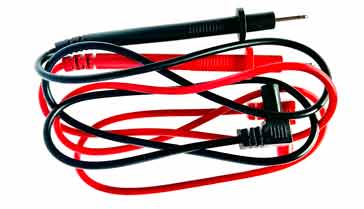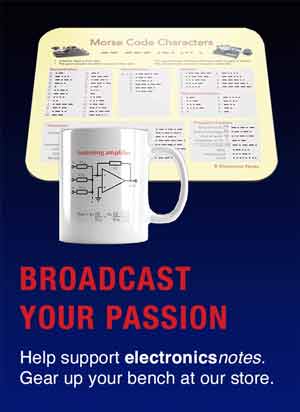Multimeter Test Leads & Probes: what you need to know
The test leads and test probes that need to be used with multimeters may be a bit of an afterthought, but they are key to making good measurements.
Multimeter Tutorial Includes:
Test meter basics
Analogue multimeter
How does an analogue multimeter work
DMM digital multimeter
How a DMM works
DMM accuracy & resolution
DMM CAT ratings
How to buy best digital multimeter
Cheap vs expensive DMM
How to use a multimeter
Voltage measurement
Current measurements
Resistance measurements
Diode & transistor test
Fault finding transistor circuits
Analogue vs Digital multimeter
Test leads & probes
Most test meters or multimeters will come with a set of leads with probes which are intended for use with the instrument.
These test leads with their probes are very important and they can sometimes mean the difference between a good measurement and one that can be misleading.

Today's test leads & probes
Today multimeter test leads and probes usually consist of a specially protected connector at the meter end. This prevents the possibility of a terminal being exposed at the meter with the associated risk of accidental touching which coud be very dangerous if high voltages are being probed.
The remote end or probe end normally has a pointed probe to interface with the item under test.
Care must be taken, though with the probing end not to touch the probe itself, particularly when testing high voltage or other critical points.
Probes and clips
Normally the test leads provided with the meter may only have pointed ends to probe a circuit, but it is also often possible to buy additional probes and clips to enable more convenient and better probing of the circuit under test.
In many instances a sharp point on the probe is needed to penetrate any oxide or dirt that may have accumulated on the node on the circuit that needs probing.
Sharp points may also be useful in penetrating any solder resist on a point on a circuit that might need probing.
Points to watch
When probing a circuit, it is essential to ensure that the probes do not slip.
Sometimes it can be difficult to hold two probes firmly in place at the same time. This is where a crocodile / alligator clip that can be attached to a suitable earth point becomes invaluable. But make sure this clip cannot slip and cause a short circuit that might cause damage. Often clipping to a specific earth terminal or the chassis (if available) is best.
Usually the clips have insulation around the clip so that only the part used to contact the ground point or terminal is not covered.
This can significantly help in reducing the likelihood of the clip contacting another point on the equipment and causing a short circuit.
Test probes and resistance measurements
One point to watch is that when taking resistance measurements, is that good contact must be made with the probes otherwise additional resistance can be added.
Sometimes the displayed resistance can change erratically if the leads are not held tightly onto the component under test.
While multimeter probes may be taken for granted, having a good set of leads and probe ends will make testing much easier, especially of the probe ends can be interchanged to provide the most convenient connection.
Also buying good quality probes will ensure that the leads and probes are not only made to a high standard and will last the rigours of everyday use, but good quality equipment will also ensure that safety standards are maintained.
 Written by Ian Poole .
Written by Ian Poole .
Experienced electronics engineer and author.
More Test Topics:
Data network analyzer
Digital Multimeter
Frequency counter
Oscilloscope
Signal generators
Spectrum analyzer
LCR meter
Dip meter, GDO
Logic analyzer
RF power meter
RF signal generator
Logic probe
PAT testing & testers
Time domain reflectometer
Vector network analyzer
PXI
GPIB
Boundary scan / JTAG
Data acquisition
Return to Test menu . . .




